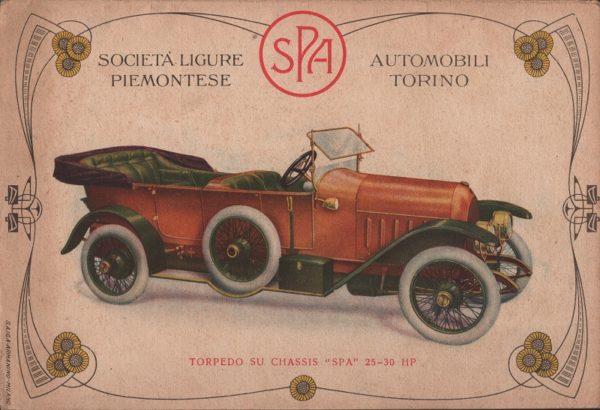
Early Italian motor car manufacturers seemed to delight in using initials to abbreviate their full names – and SPA was a particularly fine example.
SPA stood for Società Piemontese Automobili. It was founded in 1906 in Turin by Matteo Ceirano and Michele Ansaldi to make motor cars, military vehicles and aero engines. The chief designer was Alberto Ballacco.
In 1908 the company merged with Fabbrica Ligure Automobili Genova (FLAG) to form Società Ligure Piemontese Automobili. Mercifully the acronym remained as SPA. The headquarters moved to Genoa and then in 1923 returned to Turin, where manufacture had always been located.
FIAT took the company over in 1925 and car manufacture ended – but commercial and military vehicles were still produced. The company’s name finally disappeared in 1947 with total absorption into FIAT.
The car in our Snapshot was advertised on the back cover of the August 1916 issue of the monthly magazine Rivista Mensile del Touring Club Italiano. This fine publication was noted for its delightful full-colour cover advertisements on the front and back covers. From 1917 its supplement, Le Vie d’Italia, continued this tradition until 1968.
The car is the 25-30 HP with a torpedo body. It was powered by a 4,400cc six-cylinder L-head monobloc engine and featured a unitary gearbox and high-tension magneto ignition system. Its smaller sisters were two four-cylinder cars: the 12-15 HP with 1,846cc and the 14-16 HP with 2,700cc. These cars, launched around 1911, stopped production at some time during World War I and resumed thereafter, but 1922 saw the introduction of the sophisticated 30/40 Super Sports, still with a 4,400cc six-cylinder engine but now with twin overhead camshafts operating four valves per cylinder. By 1923 the range was marketed as Tipo 23, Tipo 24 and Tipo 25, with the twin-cam sporting versions of each being distinguished by V-shaped radiators.
The Ceirano brothers, Giovanni Battista, Giovanni, Ernesto and Matteo, were influential players in the Italian motor industry, being responsible between them for Ceirano, Welleyes, STAR/Rapid, SCAT, Itala and SPA – and Giovanni’s son Giovanni “Ernesto” co-founded Giovanni Ceirano Fabbrica Automobili and Fabbrica Anonima Torinese Automobili (FATA).
If you are exhausted after reading all that Italian, so are we… but isn’t it a lovely language?
Picture courtesy of the Richard Roberts Archive







Leave a Comment